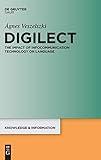Digilect : The Impact of Infocommunication Technology on Language / Ágnes Veszelszki.
Material type: TextSeries: Knowledge and Information : Studies in Information SciencePublisher: Berlin ; Boston : De Gruyter Saur, [2017]Copyright date: ©2017Description: 1 online resource (X, 356 p.)Content type:
TextSeries: Knowledge and Information : Studies in Information SciencePublisher: Berlin ; Boston : De Gruyter Saur, [2017]Copyright date: ©2017Description: 1 online resource (X, 356 p.)Content type: - 9783110499902
- 9783110497137
- 9783110499117
- Communication and technology
- Communication -- Technology
- Computational linguistics
- Digital communications -- Social aspects
- Digital communications
- Digital media
- Language and languages -- Computer network resources
- Digital
- Internet
- Sprachvariante
- LANGUAGE ARTS & DISCIPLINES / Library & Information Science / General
- Digital
- Internet
- Variety
- 418.00285
- P53.285 .V37 2017
- P53.285
- online - DeGruyter
- Issued also in print.
| Item type | Current library | Call number | URL | Status | Notes | Barcode | |
|---|---|---|---|---|---|---|---|
 eBook
eBook
|
Biblioteca "Angelicum" Pont. Univ. S.Tommaso d'Aquino Nuvola online | online - DeGruyter (Browse shelf(Opens below)) | Online access | Not for loan (Accesso limitato) | Accesso per gli utenti autorizzati / Access for authorized users | (dgr)9783110499117 |
Browsing Biblioteca "Angelicum" Pont. Univ. S.Tommaso d'Aquino shelves, Shelving location: Nuvola online Close shelf browser (Hides shelf browser)

|

|

|

|

|

|

|
||
| online - DeGruyter Martin Luther : A Christian between Reforms and Modernity (1517-2017) / | online - DeGruyter Conrad Gessner (1516-1565) : Die Renaissance der Wissenschaften/The Renaissance of Learning / | online - DeGruyter Funktionen des Lebendigen / | online - DeGruyter Digilect : The Impact of Infocommunication Technology on Language / | online - DeGruyter Aristoteles gegen Epikur : Eine Untersuchung über die Prinzipien der hellenistischen Philosophie ausgehend vom Phänomen der Bewegung / | online - DeGruyter Antike als Transformation : Konzepte zur Beschreibung kulturellen Wandels / | online - DeGruyter Lebenssinn und Erbe / |
Diss. Eötvös-Loránd-Univ Budapest 2012.
Frontmatter -- Contents -- Acknowledgements -- 1. Introduction: Infocommunications and Digilect -- 2. Digilect as Language Variety -- 3. Characteristic Features of Digilect -- 4. Digilect (and its Effects) based on the Findings of Two Questionnaire Surveys -- 5. The Impact of Digilect on non-digital Media According to Corpus Analysis Findings -- 6. Summary and conclusions. Directions for further research -- Annex 1 -- Annex 2 -- Annex 3 -- Annex 4 -- Annex 5 -- Annex 6 -- Annex 7 -- Annex 8 -- Annex 9 -- Annex 10 -- Annex 11 -- Annex 12 -- References -- Index
restricted access online access with authorization star
http://purl.org/coar/access_right/c_16ec
The high degree of internet penetration and its social (and linguistic) effects evidently influence how people, and especially the highly susceptible younger generations, use language. The primary aim of the book is not only to identify the characteristic features of the digital language variety (this has already been done by several works) but to examine how digital communication affects the language of other mediums of communication: orality, handwritten texts, digitally created but not digitally perceived, that is printed texts, including in particular advertisements (which quickly respond to linguistic change). Naturally, the book presents the characteristics of the digital language variety (and coins the term digilect) but only to give a framework to the impact analysis. It is important to document changes in progress and thus direct attention to potential outcomes. The current linguistic change is different from previous ones primarily in its speed and form of spreading, and it not only brings innovative grammatical forms and writing/spelling solutions but may also have far-reaching cultural and educational consequences in the long run.
Issued also in print.
Mode of access: Internet via World Wide Web.
In English.
Description based on online resource; title from PDF title page (publisher's Web site, viewed 25. Jun 2024)


